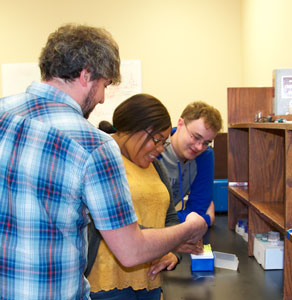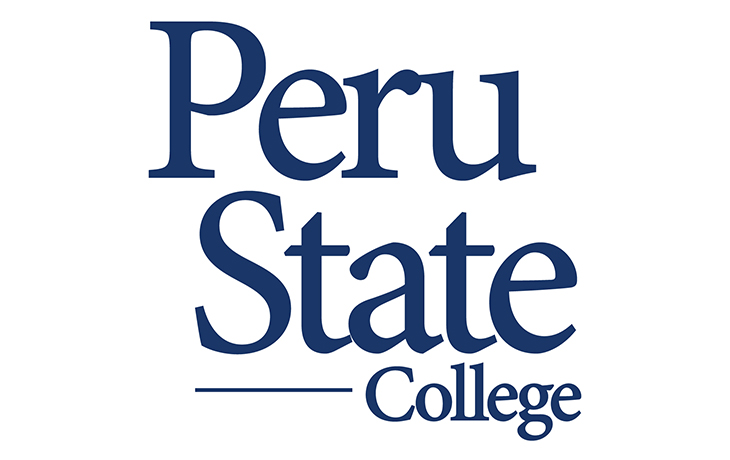Peru, Nebraska – Dr. Nate Netzer is new to the Peru State campus, but he continues the long tradition of faculty-guided student research. In conjunction with a National Science Foundation Grant and the University of South Dakota, Netzer is leading research in nanotechnology with the help of student researchers, Dylan George and Carlene Riley.
Nanotechnology may be the spark for science-fiction ideas, but the use of tiny technologies is real. The prefix nano- indicates extreme smallness and a nanometer lives up to this definition, being equal to .000000001 meters.
“Chop a meter stick into a billion pieces and each piece is a nanometer,” Netzer explains, “A nano is a small and specific size, so nanotechnology is using materials at the nano scale.”
Some of the nanotechnology experiments organized by Netzer use MOSC (Metal Organic Super Containers). Three dimensional models of the MOSC on Netzer’s computer show molecules specially built with cavities to contain other materials.
George said, “We use the MOSC to trap to whatever we are looking for – for example, charged ions. The charged ions will bind into the cups or cavities on the MOSC.”
Netzer adds, “That’s why these (multiple binding cavities) are called super containers in the first place. In our example, when we capture charged ions, this creates an ion-selective electrode.”

Dr. Nate Netzer working with student researchers, Carlene Riley and Dylan George.
“That electrode can then detect like ions that have an impact on biologically and environmentally important issues. For example, we have used this to detect methylene blue. Methylene blue is sometimes released into water supplies which can be harmful to aquatic life.”
Netzer provides another example of possible use, “Acetylcholine is a neurotransmitter associated with Parkinson’s Disease. If we can detect it through these ion-selective electrodes we can detect early onset Parkinson’s.”
Netzer is quick to add that detecting the methylene blue or acetylcholine is only the first step in solving a problem, “Detecting acetylcholine would create another tool for Parkinson’s Disease researchers, letting them potentially treat the disease at an earlier stage.”
Student researchers are also working on metallic nanostructures using nano-scale gold and silver to study surface-enhanced Raman spectroscopy (SERS). SERS can identify a substance at the molecular level and has potential uses for any organization -for example Homeland Security – that must identify unknown substances.
The student researchers not only work with Netzer to conduct the experiments, but to create the materials and tools needed for their work. Dylan George notes the equipment is extremely easy to construct for the MOSC experiments.
Dr. Rick Wang at the University of South Dakota synthesizes the MOSC for Peru State’s experiments. Using a solution of MOSC, George and Riley then turn simple pipettes into potential ion-selective electrodes.
The students take pipettes and dip them in the MOSC solution to create a mixed matrix membrane (MMMs). During the experiment, the membrane will measure the solution’s potential to create an ion-selective electrode.
Carlene Riley adds, “We took the MOSC MMMs and looked under the microscope to make sure there are no blobs, no cracks, air bubbles or anything that might throw off potentiometric (voltage) measurements.”
To be a better conductor, the membrane should look smooth and clear. Riley says about 25% of the time there is an anomaly.
Netzer demonstrated how the these ion-selective electrodes are used in the experiment versus a control electrode. The control electrode has no potential difference from the solution, but if the MOSC is working the ion-selective electrode should have a difference from the solution that starts at zero and builds.
Dylan George is a natural sciences major from Beatrice, Nebraska. Carlene Riley from Grand Island, Nebraska, and is studying biochemical science.
Dr. Netzer is a Assistant Professor of Chemistry in the School of Arts and Sciences. He previously worked in a post-doctoral position at Uppsala University in Uppsala, Sweden, where he conducted research on environmental and biological sensors in the Solid State Electronics Department at the Ångstrom Laboratory for two years.
Netzer received his bachelor’s, master’s and Ph.D degrees from the University of South Dakota. During his time at USD, he served as a guest researcher for three summers at NASA’s Ames Research Center in Mountain View, California, working on sensing platforms used by the Mars (MSL) Curiosity Rover.
###
